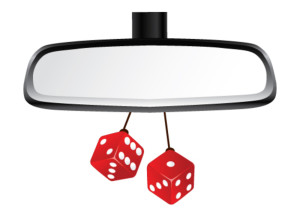My last blog post focused on the post-exit identity crisis, the “Who am I if not my company?” question. I wrote about business owners who might feel lost in transition between the nametag they have always worn—“Business Owner”—and a new tag without a title. I suggested an alternate route around this road hazard by mining the power of the past. Reflect and take stock of your strengths and accomplishments. They are fuel for the future.
I ended that blog post with a quote from Kierkegaard: “Life can only be understood backwards; but it must be lived forwards.” While you need insight into what satisfied and motivated you in your past, you also need images of what your next stage of life could look like. Crafting this ambiguous future image is often very difficult, and so you put it off. But if you avoid the second piece of work, you’re hitting the road with nothing but a rearview mirror and some lucky dice.
Without a sense of the future, you will likely avoid exit planning. Alternatively—and just as serious—you will exit the high-speed autobahn of business owner and find yourself a meandering back road lacking interest, direction or meaning.
Imagination at Work
Boomers are using their imaginations to define “what’s next.” So must you.
Your options are not tied to the size of a payout, to economic or family circumstances, or to age upon exit. Today, 60% of Boomers view retirement as “a new, exciting chapter in life” compared to 52% in previous years. Only 14% see retirement as a time to “take a well-deserved rest.” Boomers want to be engaged during retirement—either in work or helping—i.e., they want to be active, involved and using their skills to help others. You can be too.
Rev Up the Possibilities for Life Post-Departure.
I remember learning to drive a standard-transmission car at age 16. I would gingerly let out the clutch and drive in first gear for a long as I could before I absolutely had to shift again. I did the same thing in second and third gears. Those transitions took time to learn and to get the feel of the clutch engaging. It’s not that different from figuring out how to transition to an ambiguous future. Here are some thoughts on how to make that shift.
First Gear
To get off the starting line, there are two rules—embrace uncertainty and imagine multiple options.
- Like early driving, be prepared for the possibility that you might stall or have a jerky start. Trust that you will find that point where the uncertainty of it all shifts to greater confidence.
- Give yourself permission to live with ambiguity and messiness. Yes, it’s uncomfortable. That’s how learning can be.
The smooth shift is possible when you follow rule two: imagine a range of future options. First gear is for exploration and imagination, not decision-making and closure. Instead of honing in on one idea you may have been considering and detailing a plan to test its feasibility, you allow yourself to explore many ideas—from the practical to the fantastical, with stops in between.
- Talk with others about how they explored their post-departure life.
- Read some of the great books and blogs advising Boomers about “rewiring” or “re-firing” and “re-inventing.”
- Consider participating in online groups like Life Reimagined, whose purpose is to help people facing retirement “define, and shape their lives and find happiness and purpose ….”
- Translate (don’t replicate) those amazing times and achievements in your past—and what made them so—into new or enduring endeavors, roles and relationships that might provide that same satisfaction.
- Look at those postponed activities of earlier years that still fire your imagination and energy.
Keep a running list of all that might be in your future. Don’t judge or evaluate them yet.
Second Gear
To gear up, we learned two more rules: depress that clutch, and when you shift, don’t be afraid to step on the gas! If we are tentative with the clutch and gas, we don’t move cleanly, and it causes a lot of noisy grinding. That’s the same as trying to hold on to aspects of your past that don’t fuel your future.
In post-exit planning, you decide what to carry forward and what to leave behind. For example, you may carry forward your passion for leading initiatives but let go of the need to manage all the details. You may discard the habit of multi-tasking and carry forward the ability to meet tough challenges. What will serve you well; what will hold you back?
Shifting into second gear enables you to pick up speed, but only if you step on the gas. So you fast-track many small experiments to test and learn what fulfills you. You start small, pick up new experiences and insights, and gain speed in finding your direction. You don’t expect to cover a lot of distance quickly. If you imagine and dream of creating a new nonprofit or moving to France, you start by serving on a nonprofit board or renting an apartment in Paris for 3 months.
Third or High Gear
Remember this hint: this gear lets you obtain your top speed and cruise comfortably without stressing the engine. That happens when you
- build on what you learned in second gear: adjusting, refining or even re-imagining again, and
- connect with those who support your moving forward. Shifting into third means traffic is clear and so are you—about where you’re headed and at what speed.
 Before four-speed transmissions, this was the gear where you could also put an arm around a date. It was a great feeling, knowing you had people you cared about with you on the road. Ask most business owners what they will miss about “the old place” and they will tell you “my people” or “my friends.” In this phase of planning for your post-exit, staying connected and building connections provides emotional strength, prevents isolation and accelerates your transition.
Before four-speed transmissions, this was the gear where you could also put an arm around a date. It was a great feeling, knowing you had people you cared about with you on the road. Ask most business owners what they will miss about “the old place” and they will tell you “my people” or “my friends.” In this phase of planning for your post-exit, staying connected and building connections provides emotional strength, prevents isolation and accelerates your transition.
Facing the question “Who am I if not my company?” is an act of courage for an important transition that all business owners face. I hope imagining it more simply as a driving process that most of us mastered long ago makes it less daunting.
In my forthcoming book Exit Signs I write in more depth and provide tools to help you through mining the past and imagining the future.

